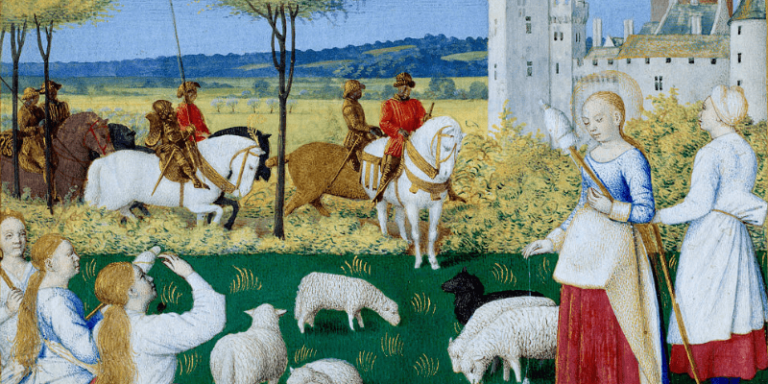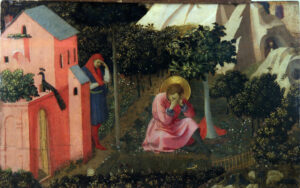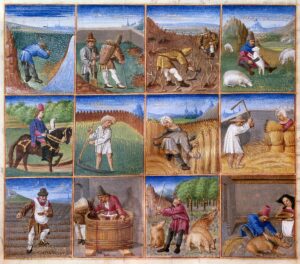Understanding the Dark Ages
Some historians no longer think the dark ages were so dark – could they be right?
By: Caroline Adana | June 3, 2021 | 735 Words

(Photo by Leemage/Corbis via Getty Images)
In the 1300s, the Italian scholar Petrarch came up with the term “dark ages” to describe European society between the fall of the Roman Empire and the rise of the Renaissance. He was comparing the “dark” centuries of society in Europe to the glory and “light” he associated with the ancient world.
A Dark Age
The centuries between the fall of Rome and the early Renaissance, the period of approximately A.D. 500-1300, has been called the Dark Ages because it was an era in Western Europe where it appears written language nearly disappeared and global trade vanished. Entire industries disappeared along with their tools and knowledge. So, what lead to this change in Europe?

The Conversion of Saint Augustine. Artist Angelico, Fra Giovanni, da Fiesole. (Photo by Fine Art Images/Heritage Images via Getty Images).
St. Augustine
Edward Gibbon, the 18th century historian, thought Christianity was to blame. Gibbon’s history of Rome was highly influential on how we thought about the Dark Ages, and he blamed religion. Today, we know that this view is mostly false but contains an element of truth.
St. Augustine, who lived in the fourth century, had a huge impact on the development of Christianity. He was influenced by the Greek philosopher Plato, who taught that the world we live in is impure and imperfect compared to the world of ideas.
Augustine’s influence steered people’s focus away from the material world and toward a spiritual outlook. Exploring the material world was not valued, and neither was gaining knowledge about physics, medicine, technology, or other forms of practical knowledge. This is one reason it took so long for Europe to recover from the fall of Rome.

(Photo by Leemage/Corbis via Getty Images)
However, Christianity contributed to bringing up the birth rates in the Roman Empire, which prevented a demographic collapse. While Christians in the western part of the collapsing Roman Empire turned away from earthly learning, the Christians in the eastern part maintained writings, buildings, and technology even during the Dark Ages. This group was based in Constantinople (now Istanbul), and formed the Byzantine Empire.
Volcanoes and Plagues
Two massive volcano eruptions in A.D. 536 and A.D. 540 caused a period of extensive global cooling that ruined crops and caused starvation.
As if that weren’t bad enough, in A.D. 541, the greatest pandemic in the ancient world came. It is known as the Plague of Justinian and was the first in a series of deadly pandemics that devastated society.
In a single year, the plague killed an estimated 25 million people. In total, more than 50 million are believed to have perished, or about 20% of the population. By comparison, COVID-19 has killed 0.04% of the world’s population. The Justinian Plague was 500 times more deadly.
The Conquest of Islam
After plagues and starvation had weakened the West, a new religious sect from the Arabian deserts grew to prominence: Islam. In 20 short years, between A.D. 630 and A.D. 650, Muslims conquered 50% of Christendom, including what is today known as Egypt, Morocco, Libya, Tunisia, Syria, Jordan, Iraq, and large parts of Turkey.
During this time, European trade on the Mediterranean Sea became near impossible due to Muslim pirates. Therefore, one of the most efficient trade routes in the ancient world was effectively shut down, thereby contributing further to the economic depression and isolation of the Dark Ages.
Ultimately, Islam won against the Byzantine Empire, and in 1453, Constantinople fell to Sultan Mehmed the Conqueror.
Although Christian Europe defended itself against Islam for a thousand years of conquest, the Muslim world also brought benefits. The Arab world brought scientific advancements to Europe, including the Hindu-Arabic numeral system, which we still use for numbers today. Many ancient Greek texts of Aristotle were also reintroduced into Europe via Muslims. All this knowledge would help spark the scientific revolution.
A New Debate: Were the Dark Ages Real?
Were the Dark Ages actually that dark? Today’s historians aren’t convinced the so-called “dark ages” were as bad as previously thought. Many have a more positive view of Europe during this time, now more commonly called the Middle Ages or the Medieval period. Some point out accomplishments of the time, while others suggest that we simply don’t know enough about the period to say what it was really like.
















